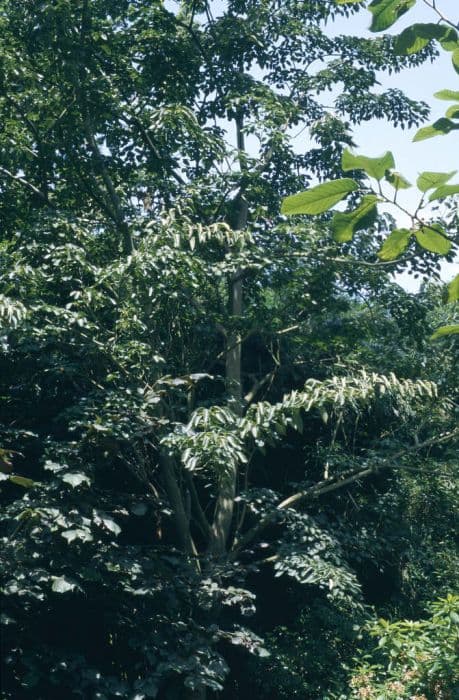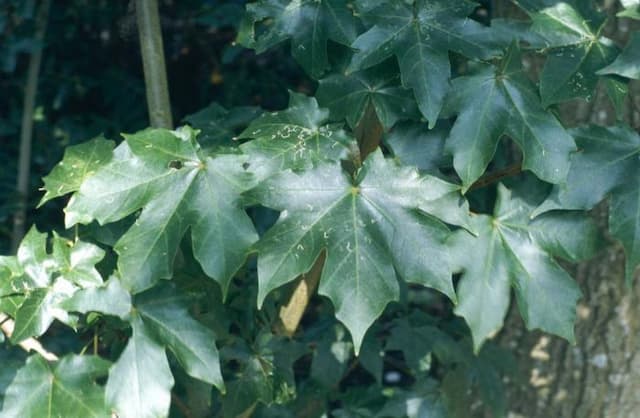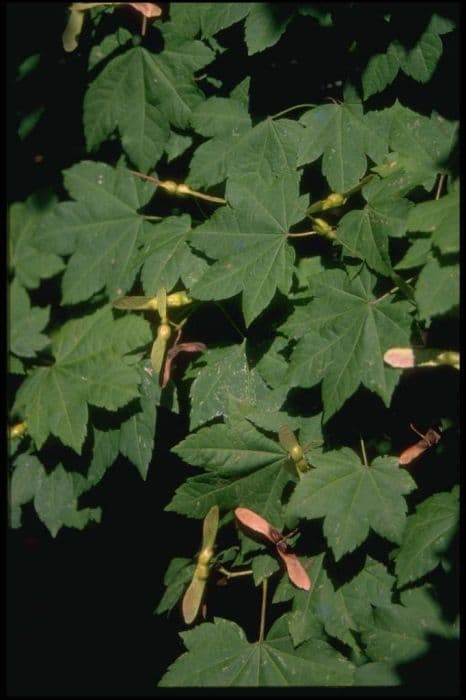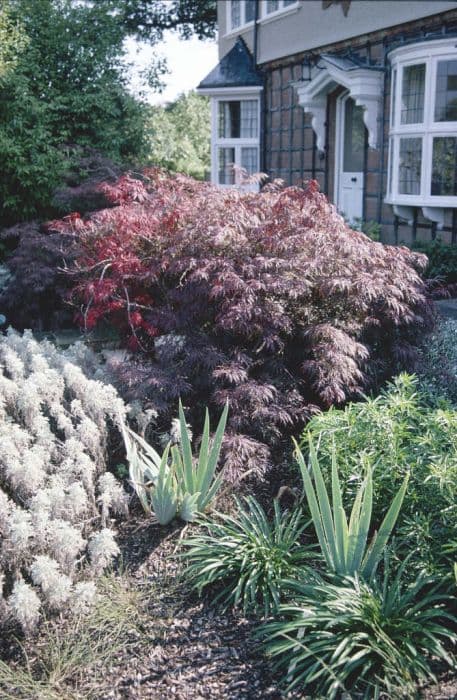Kyushu Maple Acer capillipes

ABOUT
Acer capillipes, commonly known as the Red Snakebark Maple, is a visually striking plant known for its ornamental features. This plant is particularly noted for its attractive bark, which is smooth and olive green with distinctive, regularly spaced white stripes that give it a snakeskin-like pattern, resulting in its common name. The leaves of the Red Snakebark Maple are arranged in a classic maple shape, with three to five lobes and sharply pointed tips. They showcase a pleasing texture and offer a beautiful array of colors throughout the seasons. In the spring and summer, the foliage is a fresh, bright green, creating a vibrant canopy of leaves, which then transition to brilliant shades of yellow, orange, or red in the fall before shedding. In the spring, small yellow-green flowers emerge, providing a contrast to the rich green foliage. The flowers are arranged in drooping clusters, which, after pollination, develop into winged seeds known as samaras. These seeds are typically paired and can helicopter away from the parent tree to colonize new areas. The Red Snakebark Maple bears a graceful appearance, with a branching pattern that can be either upright or spreading, lending a layer of visual interest to any garden or landscape where the size of the tree is suitable. It's a favorite among gardeners and landscape designers for its distinctive bark and changing leaf colors, which add year-round interest to any setting where the climate is appropriate for its growth.
About this plant
 Names
NamesFamily
Sapindaceae
Synonyms
Kyushu Maple, Red Snakebark Maple, Stripebark Maple
Common names
Acer capillipes.
 Toxicity
ToxicityTo humans
The plant Acer capillipes, commonly known as the Kyushu maple or Red snake-bark maple, is not typically considered toxic to humans. There is no well-documented evidence of toxicity in humans resulting from ingestion of parts of this plant. As with any plant, individual allergic reactions or sensitivities are possible, but the Kyushu maple is generally not associated with toxic effects when touched or ingested.
To pets
Acer capillipes, known as the Kyushu maple or Red snake-bark maple, is also not known to be toxic to pets. There are no specific symptoms of poisoning associated with this plant for common domestic animals like cats and dogs, as it is not listed among plants that are usually hazardous to pets. However, ingesting any non-food plant material can potentially cause mild stomach upset in some animals due to irritation of the digestive tract, but this does not relate to particular toxins in the Kyushu maple.
 Characteristics
CharacteristicsLife cycle
Perennials
Foliage type
Deciduous
Color of leaves
Green
Flower color
Yellow
Height
30 feet (9.14 meters)
Spread
20 feet (6.1 meters)
Plant type
Tree
Hardiness zones
5
Native area
Japan
Benefits
 General Benefits
General Benefits- Aesthetic Appeal: Adds visual interest to landscapes with its striking red and white striped bark and attractive foliage.
- Shade Provider: Offers shade in gardens and parks with its spreading canopy.
- Habitat Support: Serves as a habitat and food source for wildlife such as birds and insects.
- Seasonal Interest: Features vibrant seasonal changes including spring flowers, summer leaves, and striking autumn colors.
- Erosion Control: Can help to stabilize soil with its root system, preventing erosion on slopes.
- Adaptability: Tolerates a variety of soil conditions and urban pollution, making it suitable for diverse locations.
- Low Maintenance: Requires minimal pruning and care once established, making it an easy choice for gardeners.
 Medical Properties
Medical PropertiesThis plant is not used for medical purposes.
 Air-purifying Qualities
Air-purifying QualitiesThis plant is not specifically known for air purifying qualities.
 Other Uses
Other Uses- Acer capillipes, commonly known as Red Snake-bark Maple, can be utilized in woodworking for its beautifully patterned and colored wood, which is ideal for crafting decorative objects or furniture accents.
- The tree's distinct bark can also be used as a natural inspiration for textures in artwork, providing artists with a unique pattern to replicate in paintings, sculptures, or fabric designs.
- Bonsai enthusiasts may find Red Snake-bark Maple to be an excellent candidate due to its attractive bark and foliage, offering a distinctive addition to their collections.
- The seeds of the Red Snake-bark Maple can be stratified and germinated for educational purposes, teaching about the life cycle of trees and the process of seedling development.
- As a source of shade and coolness, this tree can be planted in urban environments to contribute to the reduction of the heat island effect, making cities more comfortable during hot weather.
- The tree's fall foliage is a spectacular sight and can be used in landscape photography, providing a vibrant backdrop for outdoor portraits and sceneries.
- Red Snake-bark Maple can serve as a natural dye source; the bark and leaves may yield colors for textile dyeing when processed appropriately.
- Its distinctive and attractive appearance makes it a valuable specimen for arboretums and educational gardens, where it can help to teach about tree diversity and identification.
- The leaves of the Red Snake-bark Maple can be used in composting to enrich the soil with organic matter, improving garden soil quality and supporting sustainable horticulture practices.
- By planting Red Snake-bark Maple within larger reforestation projects, it can add to the biodiversity of the newly established or restored ecosystems, supporting a variety of wildlife.
Interesting Facts
 Feng Shui
Feng ShuiThe Japanese Maple is not used in Feng Shui practice.
 Zodiac Sign Compitability
Zodiac Sign CompitabilityThe Japanese Maple is not used in astrology practice.
 Plant Symbolism
Plant Symbolism- Resilience: Acer capillipes, commonly known as the Red Snakebark Maple, has a decorative bark that peels and reveals resilient underlayers, symbolizing the ability to endure and recover from challenges.
- Strength: As a member of the Maple family, this tree represents strength and endurance, capable of withstanding the changing seasons and various environmental conditions.
- Growth and Expansion: Similar to many trees, the Red Snakebark Maple represents growth, not only physical but personal growth and the expansion of one's own boundaries over time.
- Balance: The leaves of the Maple tree change colors with the seasons, which can symbolize the balance of nature and the idea of cyclical life and balance within oneself.
- Beauty: With its striking bark and elegant stature, the Red Snakebark Maple symbolizes natural beauty and the aesthetic pleasures that the natural world can offer.
 Water
WaterThe Snakebark Maple requires moderate watering, typically receiving about 1 inch of water weekly, either through rainfall or manual watering. During dry periods, water the plant deeply once a week with about 10 gallons of water to ensure moisture reaches the root zone. Over-watering can be detrimental, so ensure the soil is moist but not waterlogged. In winter, reduce the amount as the plant's water requirements decrease. Always check the top few inches of soil for dryness before adding water.
 Light
LightThe Snakebark Maple thrives in partial shade to full sun. It is best situated in a location where it receives morning sunlight and afternoon shade, especially in regions with hot summers. The plant's leaves can suffer from scorch in excessively bright, hot conditions, so ensure it is protected during the peak daylight hours.
 Temperature
TemperatureSnakebark Maples prefer temperate climates with ideal temperatures ranging between 60 and 80 degrees Fahrenheit. They can survive minimum temperatures down to around -20 degrees Fahrenheit, but prolonged exposure to extreme cold can damage the plant. Avoid placing the Snakebark Maple in locations where temperature fluctuations are severe.
 Pruning
PruningThe Snakebark Maple should be pruned to maintain its shape and health, removing any dead or diseased branches. The best time for pruning is late winter or early spring before the sap starts to flow. Prune sparingly, as this plant does not require heavy pruning, and concentrate on maintaining a sturdy framework of branches.
 Cleaning
CleaningAs needed
 Soil
SoilThe Kyoho maple prefers a well-drained soil mix with good organic matter. A combination of loam, peat moss, and perlite can create a suitable environment. Optimal soil pH should be slightly acidic to neutral, ranging from 5.5 to 7.0.
 Repotting
RepottingKyoho maple trees should be repotted approximately every two to three years to encourage healthy growth and prevent root binding. Younger trees may require more frequent repotting.
 Humidity & Misting
Humidity & MistingKyoho maple does well in average humidity conditions and can tolerate some variations. They do not require a highly humid environment like some tropical plants.
 Suitable locations
Suitable locationsIndoor
Place Kyoho maple in bright, indirect light and ensure it's not too warm.
Outdoor
Plant Kyoho maple in partial shade and protect from strong winds.
Hardiness zone
5-7 USDA
 Life cycle
Life cycleThe life cycle of Acer capillipes, commonly known as the Kyushu maple, begins with seed germination in the spring, initiated by warmth and moisture. After germinating, the seedlings develop into saplings with characteristic green-striped bark. The saplings grow, developing a branching structure and producing leaves which undergo photosynthesis, fueling growth and development through various stages of a young tree. As the Kyushu maple matures, it reaches its reproductive phase, forming attractive red samaras (winged seeds) in the summer, which are then dispersed by wind in the fall. Over time, the mature tree will experience seasonal cycles of growth, seed production, and dormancy, often living many decades. In each dormant period during winter, the maple experiences a rest phase before resuming growth in spring, continuing its life cycle.
 Propogation
PropogationPropogation time
Late winter
The Kyushu maple, also known as Acer capillipes, can be propagated by seed or through softwood cuttings. However, the most popular method for propagating Kyushu maple is by seed. For successful germination, the seeds need to undergo a period of cold stratification, which replicates the natural wintering process. This is typically done by mixing the seeds with moist sand and storing them in a refrigerator, maintaining a temperature around 34 to 41 degrees Fahrenheit (1 to 5 degrees Celsius), for approximately 90-120 days. After stratification, the seeds are sown in a well-draining soil mix, covered lightly with soil, and kept moist until germination, which usually happens in the spring. Seedlings require protection from extreme weather and should be grown in partial shade until they are sturdy enough to be transplanted to their permanent location.









